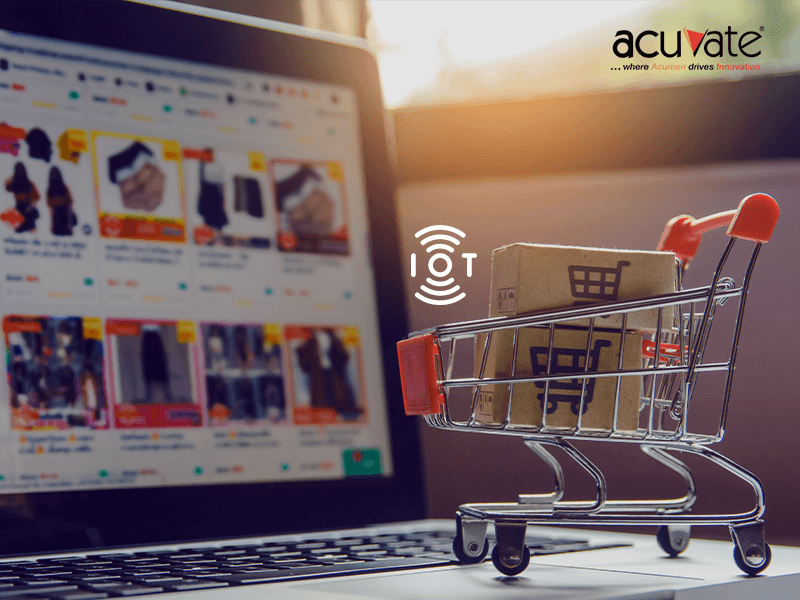The global IoT asset tracking and monitoring market is slated to reach $6.7 billion by 2028. In a world that is constantly in motion, the demand for IoT-based asset management and inventory management solution only promises to grow. Read to know why and how you can ride this wave.
There is a reason for this burgeoning growth. Managing assets and equipment and gaining real-time visibility into their location and functioning can typically be a blind spot for businesses. The ones that have suffered the most include industrial sectors like manufacturing, logistics, construction, healthcare, agriculture, livestock, cold chain, and even law enforcement.
There is a reason for this burgeoning growth. Managing assets and equipment and gaining real-time visibility into their location and functioning can typically be a blind spot for businesses. The ones that have suffered the most include industrial sectors like manufacturing, logistics, construction, healthcare, agriculture, livestock, cold chain, and even law enforcement.
Sensorization and automation have played their charm in the asset management segment, making IoT implementation popular for its many benefits. Collecting real production and inventory data, reducing waste, and shortening cycle times are examples of sophisticated IoT usage in asset management.
So let’s dive right into it.
What is IoT-based asset management?
IoT-based asset management involves using sensors and connectivity to help asset managers and other relevant employees stay updated about asset locations and functioning, streamlining recovery and maintenance, identifying problem areas, and checking inventory.
Asset management solution for manufacturing among other sectors, typically includes IoT-based asset tracking. It can help you build fail-safe replenishment systems, measure risk and compliance, and monitor asset usage and condition. The result? High performance, consistent quality, and constant availability of assets.
IoT asset tracking and management: The vital benefits
1. Remote asset tracking with IoT-based asset management
With IOT-based asset management, your employees can retrieve information on all assets anytime and anywhere. As a result, it bolsters their productivity, decision-making, and overall asset lifecycle.
Monitoring and tracking assets manually or with outdated inventory management solution for manufacturing is the reason for organizational losses. However, with IoT-based sensors and tags, you can track the performance data of individual assets.
Besides, you will get access to location data, ensuring 100% availability of assets. As a result, you can look forward to improved asset lifecycles and profit margins with improved overall equipment effectiveness.
2. Monitoring asset health with IoT-based asset management
IOT-enabled inventory management software for manufacturing and other sectors can help you assess risks concerning the health of your assets and provide recommendations for corrective action or improvement. In addition, its cost-effective and proactive nature can ensure minimal downtime for your business.
3. Asset lifecycle management with IoT-based asset management
With robust portfolios and complete visibility across assets, organizations can quickly maximize profits throughout the entire asset lifecycle.
4. Predictive asset maintenance with IoT-based asset management
Staying prepared for asset shutdowns and gaining an in-depth understanding of performance thresholds, and having solid backups – all of it is possible with IoT-based asset management.
Repairs and replacements can eat up your precious time if not appropriately managed. IoT asset tracing lets you monitor energy usage, automate routines and notifications about reached threshold values of all critical assets, and ensure safety measures and 100% compliance for best outputs.
5. Updated inventory and stock with IoT-based asset management
No one ever made profits with a poorly stocked inventory. IoT asset tracking lets you stay on track and replenish stocks before time to avoid mishaps and delays.
This helps businesses deliver customer delight consistently.
6. Asset workflow automation with IoT-based asset management
Over-reliance on manual interventions can be a recipe for revenue and productivity disasters. Automation is the key to seamless asset management. IoT asset tracking lets you streamline end-to-end processes and share asset status, health, and other parameters with the centralized systems. It ensures that all issues are solved before time and that productivity is not compromised.
IoT-based asset management lets you automate workflow tracking and report assets and material flows. Moreover, you can easily track locations to identify and fix losses and potential roadblocks.
Automation is one of the most crucial advantages of any technology implementation, and IoT-based asset management is no different. It addresses error-prone and manual tasks, accelerating employee productivity, reducing errors, and accelerating business processes.
How the industry is using IoT-based asset management
IoT-based asset management can improve business processes for several sectors. Here’s how:
1. IoT asset tracking for manufacturing
IoT aids in the collection of data from different perspectives. These include operations, production, quality, utilization, and consumption. This data can also streamline and refine business processes and make better business decisions.
A typical manufacturing plant generates data on different assets and resources as part of the production lines. But without IoT, this data goes unnoticed, is unused, and is often not even captured. As a result, businesses lose out on crucial insights like asset health, performance, usage, operational data, maintenance, logistics, and resource utilization. IoT-based asset management ensures that this data is made available and insights are utilized to improve asset lifecycle.
Manufacturing companies are gaining better visibility into their operations and significantly improving them by providing a digital identity to their physical assets with IoT-based solutions. This is a competitive advantage, and manufacturers agree. 58% of manufacturing CEOs consider IoT a strategic initiative for their business growth.
2. IoT asset tracking for logistics
Did you know that in the US, more than 70% of all goods and 95% of manufactured goods are transported by trucks? It is crucial that logistics and fleet companies have complete visibility into their assets to keep up with supply chain demands and meet customer needs. IoT-based asset management comes to the rescue.
Location and route management capabilities of IoT-based asset management are gaining massive popularity in the logistics sector. These solutions enable logistics managers to monitor and track the location of their trucks in real time.
By using GPS tracking systems and geofencing techniques, routes can also be monitored from remote locations. This further helps the logistics companies track driver activities and ensure timely cargo delivery.
3. IoT asset tracking for construction
As urbanization proliferates, the construction industry is undergoing a massive transformation to improve efficiency, worker well-being, and process improvements.
As the sector adopts IoT-based asset tracking solutions, it is improving several processes and decisions. For example, IoT interventions in the construction asset lifecycle provide real-time visibility into critical matters like worker safety and efficiency, equipment safety and functioning, and inventory and energy utilization.
4. IoT asset tracking for education
The education sector is transforming with the increased use of expensive devices like smart blackboards, laptops and tablets, and even sensitive lab equipment and materials across urban and remote rural centers.
IoT-based asset tracking can help educational institutes monitor the health of these assets, protect idle devices from theft or breakdowns, and even control access to sensitive equipment and materials. This not only levels up the functioning of educational aids and learning environments but also keeps students, educators, and lab operators safe.
5. IoT asset tracking for healthcare
Besides monitoring patients’ health, sensorized IoT devices help track the real-time location of mission-critical medical equipment like defibrillators, nebulizers, wheelchairs, and oxygen pumps, among others. In addition, the deployment of medical staff at different locations can also be analyzed in real-time, ensuring optimized staffing for optimal care.
In addition, infections continue to be a significant concern for patients and healthcare providers in hospitals. IoT-enabled hygiene monitoring devices can prevent infectious diseases from pilfering through sensitive areas of the hospital, delivering improved care for patients and healthcare workers. IoT-based asset management also helps in critical workflows like pharmacy inventory control and optimization.
6. IoT asset tracking for agriculture
A traditional sector like agriculture stands to benefit significantly from IoT intervention. IoT-based asset tracking boosts conventional farming operations to maximize yield to meet the increasing demands, improve product quality and decrease production losses.
This happens with sensorization and GPS tracking for farming equipment. It helps farm owners monitor and conserve natural resources like water and fertilizers, track livestock, and observe soil moisture and temperatures to ensure optimal farming schedules.
In addition to improving farming efficiency, IoT asset management gives farmers insightful data for rational farm management plans, saving them time and money.
Is your asset management workflow effective?
IoT intervention is not a silver bullet. Organizations can simply not set and forget an investment as critical and far-reaching as IoT asset tracking. Consistent measurement is the key to maximizing asset management ROI.
Here are the top metrics to ensure you are spot on with your IoT asset tracking.
1. IoT asset tracking metric: Overall equipment effectiveness (OEE)
Overall equipment effectiveness is the most common yet profound metric to track IoT asset tracking efficiency. It is part of every manager’s KPI and helps them gain insights on increasing productivity and boosting asset lifecycle.
2. IoT asset tracking metric: Uptime and downtime
Reducing maintenance costs means zero to minimal downtime. Therefore, IoT-based asset management solutions must ensure higher uptimes and deliver timely alerts to prevent downtime for these interventions to be effective.
3. IoT asset tracking metric: Cost efficiency and asset optimization
Preventive maintenance with IoT-based asset management reduces operational expenditure by significant margins. Moreover, capital expenditures are further reduced with improvements in the lifecycle of machines and optimum utilization of assets.
Measuring these metrics is critical to ensure that your IoT-based asset tracking solutions bring the maximum possible benefits to your business.
Acuvate’s IoT-based Asset Management Solution: A cut above the rest
Acuvate’s IoT-based intelligent asset management solution is light years ahead of traditional asset tracking solutions. Explore the advantages of a new-age innovative and easy-to-use solution, simplified workflows, and advanced asset intelligence.
IoT-based asset management: The Acuvate advantage
With Acuvate’s innovative solution, you achieve:
Remote asset tracking – increase operational efficiency by 20%
With cloud-based superpowers, employees can retrieve information on various assets anytime, anywhere. This keeps your assets always working and your employees, always in the know.
Ensure sound asset health – increase resource availability by 25%
Acuvate’s IoT asset tracking is a cost-efficient and proactive method to evaluate risks, examine policy execution history, and gain recommendations for improved asset health.
Asset lifecycle management – increase longevity by 12%
Unorganized asset portfolios lead to a significant reduction in profits. Luckily, that is not the case with Acuvate’s IOT-based asset management solutions. A comprehensive record of assets will help you maximize revenues and profit. Moreover, you can increase their lifecycle by 10 to 12%.
Asset workflow automation – reduce unscheduled downtime by 70%
Mundane and repetitive tasks can hinder business processes, productivity, and morale. With Acuvate, you can look forward to robust automation, boosting team productivity across the asset lifecycle. In addition, improved and automated visibility into asset health improves uptime for every business.
Predictive asset maintenance – reduce safety incidents by 50%
Asset shutdowns, poor-quality compliance checks, and lack of safety measures can be detrimental to your assets, workforce, and business. Acuvate’s IoT asset tracking helps you understand performance thresholds, plan backup actions, reduce safety incidents by 45 to 50%, and stay prepared for asset shutdowns.
Smart decisions and more intelligent operations await with Acuvate’s IoT-based asset management solution
Acuvate’s IoT-based asset management solution is designed to transform workflows and build a single and comprehensive view of your distributed assets.
With 16+ years of experience in cutting-edge technologies like IoT, AI, and data analytics, Acuvate is the one-stop solution for your asset management constraints.
Get the best for your assets, leverage their potential, and increase their lifecycle. All with a single platform – Acuvate’s Intelligent Asset Management Solution.





